by W.S. Cranshaw * (1/18)
Quick Facts…
- Harlequin bug is a very brightly colored insect that is becoming more common in Colorado gardens.
- Cabbage family plants are most often damaged by harlequin bugs.
- Hand picking/crushing egg masses and elimination of plants that provide food and cover between seasons can be useful in control of harlequin bugs in small plantings.
- Some insecticides applied as sprays can be used to control harlequin bugs. These sprays are most effective against young stages of the insect.
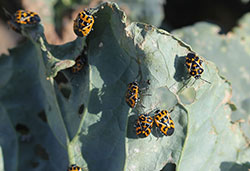
Fig. 1. Adult harlequin bugs |
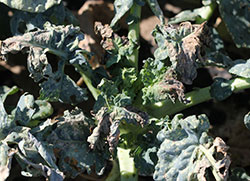
Fig. 2. Injury to broccoli produced by harlequin bugs |
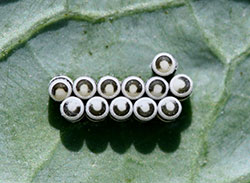
Fig. 3. Harlequin bug egg mass |
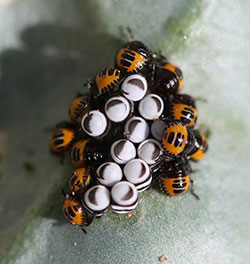
Fig. 4. Harlequin bug nymphs after hatching from eggs |
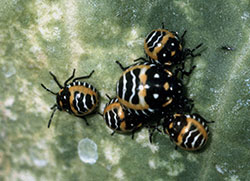
Fig. 5. Harlequin bug nymphs of mixed ages |
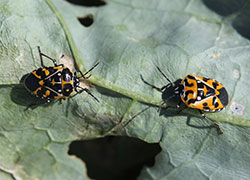
Fig. 6. Adult harlequin bugs showing a range of color and patterning |
The harlequin bug (Murgantia histrionica) is a brightly colored insect that can occur as a significant pest in gardens and vegetable crops. It feeds on several kinds of plants, mostly in the cabbage family (Brassicaceae), and can cause serious damage during outbreaks. Historically harlequin bugs have been problems restricted to southern areas of the US, but in recent years they have expanded their range northward and now can be common in many areas of Colorado. Harlequin bugs can be found in both eastern Colorado and areas of the West Slope, but most consistently occur as problems in the southeastern counties. Since harlequin bugs are not well adapted to cold temperatures, problems tend to be worse in seasons that follow mild winters.
Harlequin bugs feed with mouthparts that allow them to pierce cells and remove fluids from the plant. When feeding occurs on mature leaves, this typically results in light colored cloudy spots at feeding sites. Harlequin bugs feeding on young leaves are more damaging and kill large areas of plant tissues resulting in dead, brown patches. In high numbers harlequin bugs cause extensive wilting, distortion and may completely destroy all new growth.
Although most any plant in the cabbage family can host and be injured by harlequin bugs, some crops tend to be more consistently damaged, including turnips, kale, cabbage and mustard. Related ornamental flowering plants are also susceptible, such as sweet alyssum, Matthiola, and Erysimum. Harlequin bugs may also feed on a wide range of other non-brassica plants, particularly during outbreaks. Cleome (spider plant) is a plant that is particularly favored by harlequin bug.
Life History and Habits
Harlequin bugs survive winter in the adult stage, hidden under plant debris and other insulating cover. With return of warming temperatures in spring they emerge and seek out food plants. Various winter annual weeds, such as wild mustards, flixweed, peppergrass, and shepherd’s purse, are widely available hosts that can support the spring generation. Winter canola and other brassica crops that survive through winter, such as kale, also serve as early season hosts.
Eggs are laid in distinctive masses on the underside of leaves. The eggs are barrel-shaped, white with dark banding, and usually laid in two parallel rows. Depending on temperature the eggs will hatch in a week or two after being laid. Upon egg hatch the newly emerged nymphs will often cluster around the egg mass for a day or two before dispersing to feed.
During development harlequin bug nymphs go through a series of stages (five or six), each punctuated by a molt, during which they get progressively larger. The nymphs are wingless, and generally rounded in body form, prominently marked black and orange or red with white stripes. When full-grown the last stage nymphs molt to the winged adult form. The time it takes to complete a full generation – from when eggs are laid until mature, egg laying adults are present –takes about two months and probably two generations are normally produced annually under Colorado conditions.
Management
Eliminating food plants and cover can reduce the numbers of harlequin bugs surviving between growing seasons. Residues of crop plants that support harlequin bugs should be destroyed as soon after harvest as possible to prevent nymphs from completing development. Removal or burial of crop debris in autumn can also limit sites where harlequin bugs may find sufficient shelter for winter survival. Attention should also be given to eliminating winter annual weeds in the vicinity of plantings that can support harlequin bugs.
In small plantings it can be feasible to crush eggs by hand. A schedule of plant inspection and egg destruction maintained at a weekly interval should be sufficient for this method to be effective. Many nymphs and adults can also be removed by vacuuming. Row covers can be used to exclude harlequin bugs.
In large plantings harlequin bugs typically first infest edge rows for a few weeks before later dispersing throughout a field. Having an early growing crop that is highly favored, such as mustards or kale, planted along the field edge can serve as a temporary trap crop where harlequin bugs are concentrated. While on the trap crop harlequin bugs can then be more easily destroyed.
Some insecticides are available that can be used to assist with control of harlequin bugs (Table 1). These are most effective against young stages, and control of older nymphs and adults can be marginal with many products.
Table 1. Some insecticides that can be used to help control harlequin bugs on garden vegetable crops
| Trade Names | Comments | |
| acetamiprid | Ortho Flower, Fruit and Vegetable Insect Killer | Registered for use on most all brassica crops. 7 day preharvest interval |
| carbaryl | Sevin, Carbaryl | 3 day preharvest interval on cabbage, broccoli, and Brussels sprouts; 14 days for leafy brassicas |
| cyfluthrin | Bayer Advanced Vegetable & Garden Insect Spray | Registered for use on all brassica crops. 0 day preharvest interval |
| gamma-cyhalothrin | Spectracide Triazide Insect Killer for Lawns and Landscapes | Registered for broccoli, cabbage, Brussels sprouts, cauliflower, and Chinese cabbage. Not registered for leafy brassicas. 1 day preharvest interval |
| pyrethrins | Many garden insecticides | Registered for all brassicas. 0 day preharvest interval. Some formulations allow use in organic production. |
| insecticidal soap | Many garden insecticides | May be useful if sprayed to cover insects. Registered for all brassica. 0 day preharvest interval. Some formulations allow us in organic production. |





